I’m not a person who cries often—maybe when my kids were born, or when I’m about to finish a vacation, and definitely at the end of the film Glory.
But back on August 24th, there were a few tears of joy when my SPIEL ‘22 press badge was confirmed.
It was a cool moment. So, I flew to Germany and spent five days in Essen for this year’s SPIEL, the biggest tabletop games expo in the world. Here’s what I know now that I’ve checked one more item off of the life to-do list: board games are FOREVERRRRRRRRRRR!!!

Media Day
SPIEL is something else. In terms of size and scope, pre-COVID numbers tallied 200,000 visitors or more on a regular basis. In 2021, those numbers were cut in half, with about 96,000 visitors. 2022 numbers were approximately 150,000 visitors, if the SPIEL Twitter account is any indication.
The cool thing about the event for the media: press is given access one day early to allow for a bit more time with publishers before SPIEL opens to the masses on Thursday. So, along with a couple hundred content creators from around the world, I had the chance to sit through what was easily the most official board game press conference I’ve ever seen. Tabletop types in suits? It looked like Dreamforce for a minute, complete with a buffet breakfast, a panel, and a stage!
Then, the presser began. In German. Sadly for me, I don’t speak German!
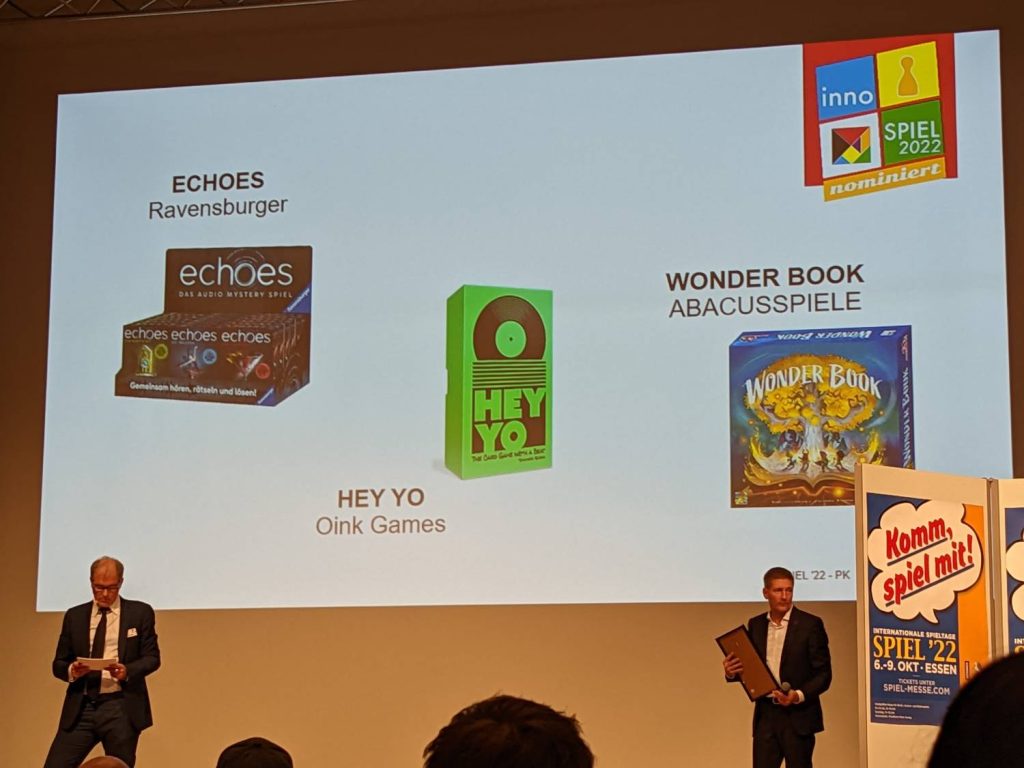
This felt like a miss, given the very intentional nature of this international trade fair, plus the fact that so many media members from other countries were in attendance. I expected the press conference to be conducted in German with English translation or a side-by-side so that English speakers would follow along. (Everywhere else in Germany, you will find English available as a second language. This is my third trip to Germany so I feel good about this sweeping generalization!)
After an hour’s worth of covering plans for this year’s event, the organizers then handed out the innoSPIEL Award for this year’s most innovative game idea. The winner was Oink Games’ 2020 release Hey Yo, a small-box release with a fun twist as players work together to play cards that (hopefully) build a successful hip-hop song.
Afterwards, the media were escorted to a room set up for us to take pictures of some of this year’s hottest games. Because this was happening outside of the normal convention, it was much easier to take great pictures of game components while speaking with members of each game’s design and publishing teams.
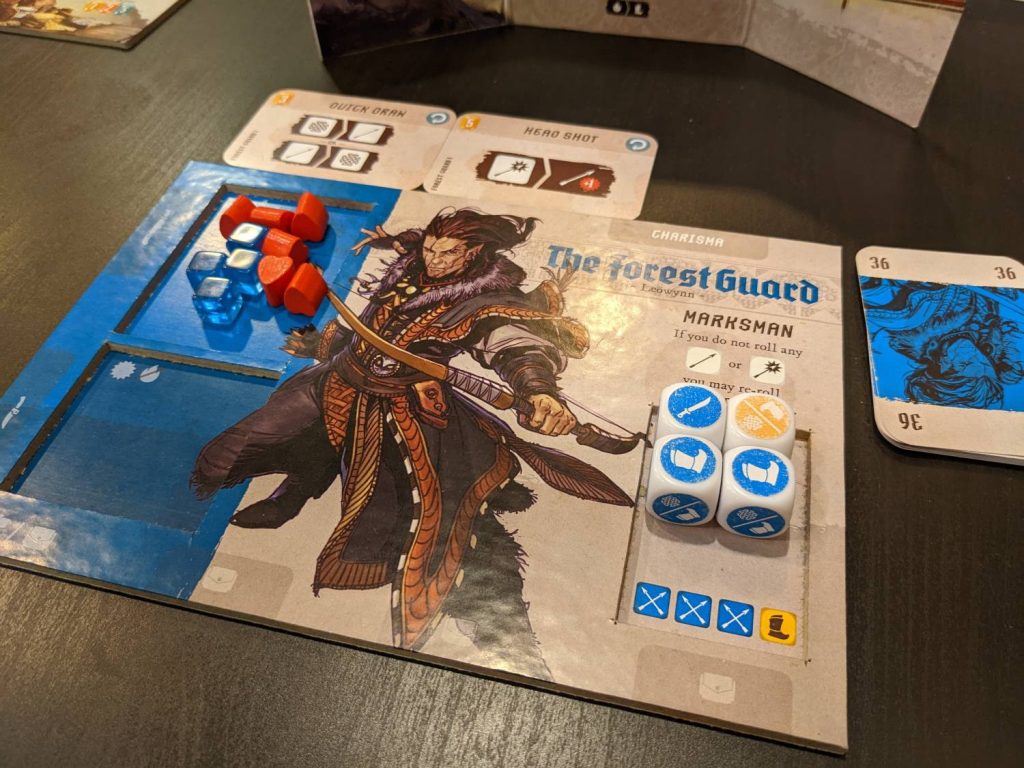
And that led to some fun conversations. It was fun to catch up with Bree Goldman from Lucky Duck Games (Destinies, as well as Tidal Blades: Banner Festival), who I’ve met at past US conventions, so it was nice to see some familiar faces. In other cases, it was fun to meet some of the people who we partner with for other content, such as the team at Mighty Boards; Vengeance: Roll & Fight—Episode 2 is one of the best roll-and-write games I’ve played this year, so I spent my time at their booth chatting about high scores as well as their upcoming games, like Hamlet and Fateforge: Chronicles of Kaan, which just wrapped up a Kickstarter campaign.
Then there were chances to chat with publishers and designers of games that I am aggressively trying to pursue in 2023: small and medium-box games, new IP, first-time publishers who are trying to make their mark.
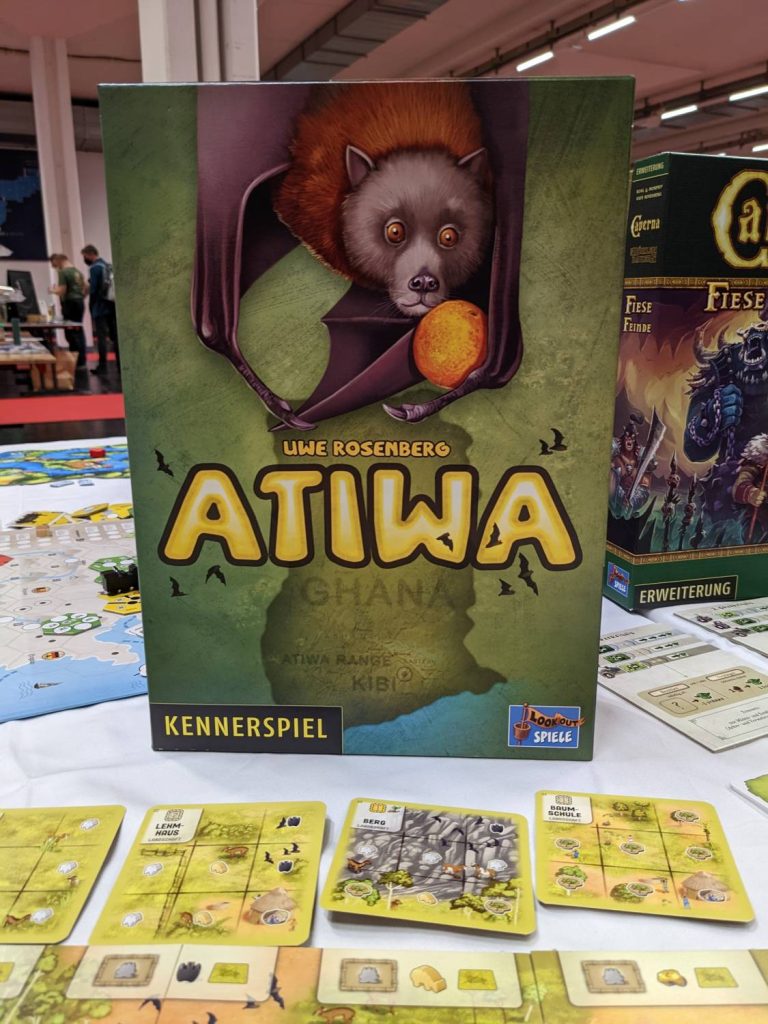
I spent time with Varnavas Timetheou, the CEO of Hegemonic Project, the publisher behind Hegemony, which had a massive 2021 crowdfunding campaign. The game is almost ready for release, so while I was taking some pictures (even the pre-production prototype looks fantastic), Varnavas and another colleague ran up to thank me for stopping by and we had a great chat about the game. I’m excited to cover this one because its themes of politics and real-world government influences are unique in a tabletop world where so many games feel like either a sci-fi game or a game about 16th-century Europe.
Similar conversations took place with reps from Battle Systems, Taiwan Boardgame Design, Portal Games, Infinite Games Ltd., and a few others. I also spoke to Bombyx, the publisher behind Sea Salt & Paper and a new flip-and-write design coming to retail by the end of this year. ISS Vanguard from Awaken Realms was something to behold in terms of its production, and a final copy was available for preview at the show.
I ended the day with a few review copies: We Can Play: Women Who Changed the World from Julibert, which was high on my pre-show list of games to try; Space Expatriate, from al-Khwarizmi Games, and Hitster, from Jumbo Spiele GmbH. These were the first of about 40 games I picked up at SPIEL this year. Let’s just say that packing these up was something else!

Day One: A Sprint, A Sit, A Massive Crowd of People
I only had one game on my must-buy list: Grand Austria Hotel: Deluxe Edition with the Let’s Waltz! expansion. (You are right—I’ve already reviewed the game, but I had to borrow a friend’s copy to do that. I wanted to have a copy all for myself.)
So, on day one of the fair, I made the sprint to the Lookout Games booth to get a copy of my own. 90 minutes later, I had my treasure in hand.

The rest of the day was a blur, in a good way: lots of great meetings, with teams from Mindclash and the Hachette family (Studio H and Funnyfox). I gathered up review copies from a few publishers and bought a few games as well, such as Arkwright: The Card Game and 1880: China.
The big thing for me was the scope of SPIEL. I’m used to hitting Gen Con and seeing a large mass of people, maybe 50-70K people, and thinking that was a big number.
Then I got to SPIEL and learned the true meaning of what a big crowd is. (My colleague Andrew Lynch’s wrap-up from last year set the table.) For perspective, one of the six expo halls at SPIEL (Hall 3) is the same size as all of Gen Con. I know this, because I was just at the Indiana Convention Center two months ago and I’ve been going to Gen Con for years.
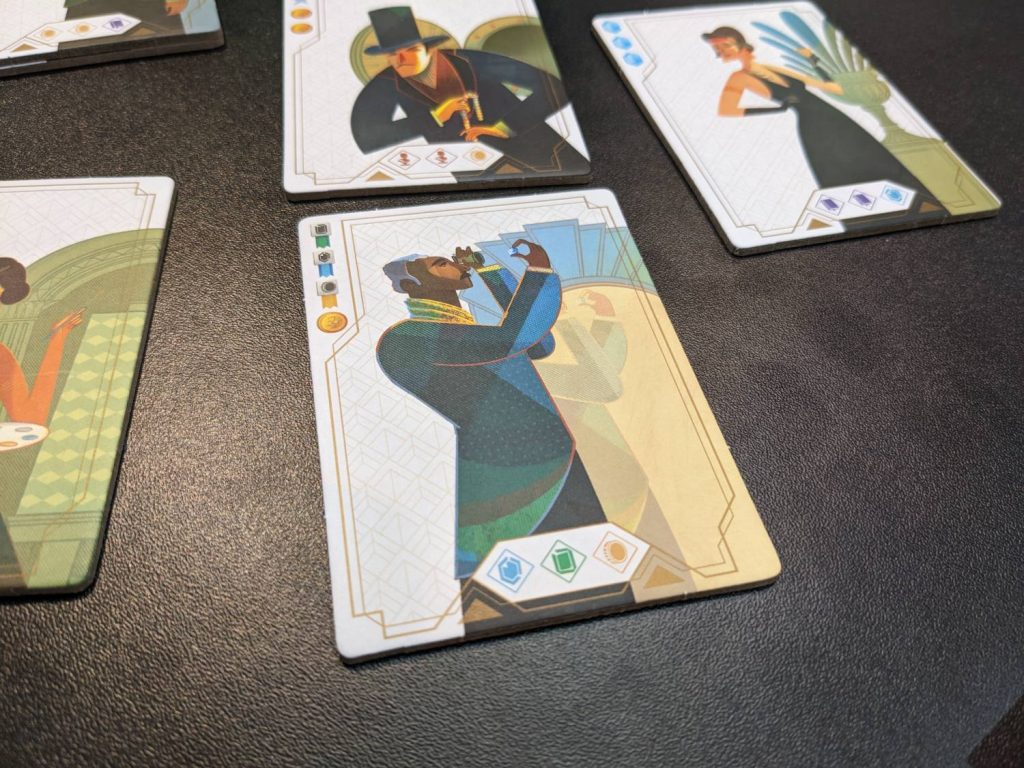
Walking from meeting to meeting at Gen Con is actually quite easy if you are meeting with a publisher who has an office or a booth on the main show floor—you can get almost anywhere in five minutes. At SPIEL, I was shocked to realize that my schedule included treks across multiple halls to get where I needed to go. I nearly had a heart attack going from my Mindclash meeting to my chat with Funnyfox. It took ten minutes and lots of my shoulder doing the talking by clearing innocent bystanders out of the way.
My Mindclash meeting started with Soma Gal, the Community Manager with the publisher of games such as Anachrony, Trickerion and Astra. After wrapping up our chat, I walked into their larger booth space and continued the conversation with CEO Viktor Peter as well as Dávid Turczi, the designer of Anachrony and so many other games it’s impossible to keep up. Robert Pratt, the Mindclash sales rep I met at Gen Con this year, was also there, and we had a great chat about rulebooks because he helped me put two and two together: he is one of the four people who helped write the rules for Tiletum.

It was fun to learn so much from all of them about their upcoming catalog. I also had a few pop-up run-ins with other partners, like Clay Ross at Capstone Games; we chatted about Terra Nova, Beer & Bread (which sold out at the German distributor on day one!), and other games that were “hot” at the show.
But I also got to embrace what makes SPIEL so special: better-than-average food, a very knowledgeable base of players, a more kid-friendly atmosphere. Also, prices are quite reasonable at SPIEL. I was expecting $50 USD games to cost €80. Instead, a lot of those $50 USD games were actually €50. Paired with the incredible euro-to-dollar conversion rates right now, I got a lot of handsome deals on great games.
A day at SPIEL is long: the expo hall hours are 10 AM – 7 PM every day but Sunday, which ends an hour earlier. I was thankful on the first day to have a meeting with some of the folks under the Hachette umbrella, and they kindly invited me to have drinks at the booth at 7 with other contacts. It was a solid night of drinks, complete with chips and champagne. It was great to meet so many other industry types under the bright lights of convention space!
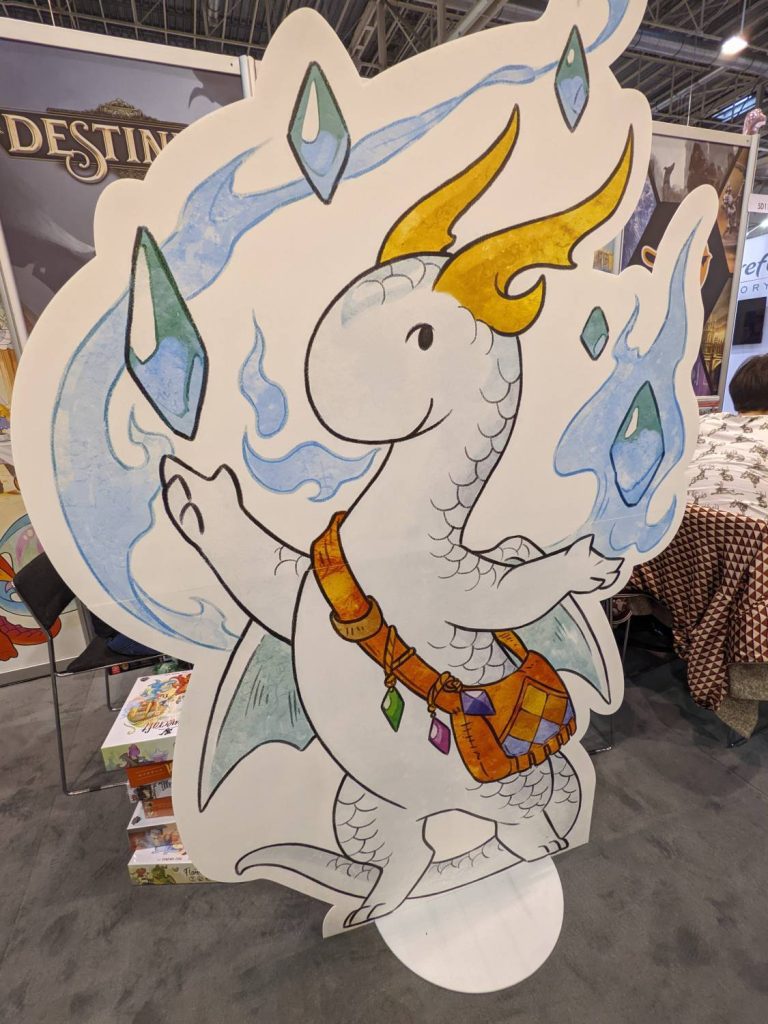
Day Two: Voidfall and Hachette
My second day at the full SPIEL event started with a bang: I stood on the U11 tram/subway platform for 30 minutes waiting to get a train to the show. (Note to self: go to SPIEL at 9 AM or at 10 AM. It’s impossible to hop on a train at 9:37 AM!!)
But once I got into the building, SPIEL day two was a whirlwind.

I had great meetings with a variety of the Hachette design studios at Sorry We Are French, GRRRE, Studio H, and Scorpion Masque. I was able to secure review copies of a few games, including Galileo Project, Nidavellir: Idavoll, the upcoming two-player card battler Gosu, Oriflamme: Alliance, and Vivarium.
I also got to try a game called Sky Team, a two-player cooperative game from Scorpion Masqué (the publisher of Turing Machine and Decrypto) that has me very intrigued; the gameplay felt unique, particularly as a two-player-only game with rolled dice hidden from the other player as the duo tries to land a plane at a major airport. This one has legs, and a big thanks to Joëlle Bouhnik from Scorpion Masqué for pairing up with me to land that plane on our final action of the Sky Team demo!
After taking a break and chatting with other industry contacts—Robert Geistlinger from Arcane Wonders, Chandler Copenhager at Backerkit, pretty much everyone at Mighty Boards—I sat down for a scheduled demo of Voidfall, the game I was most excited to see at this fair.
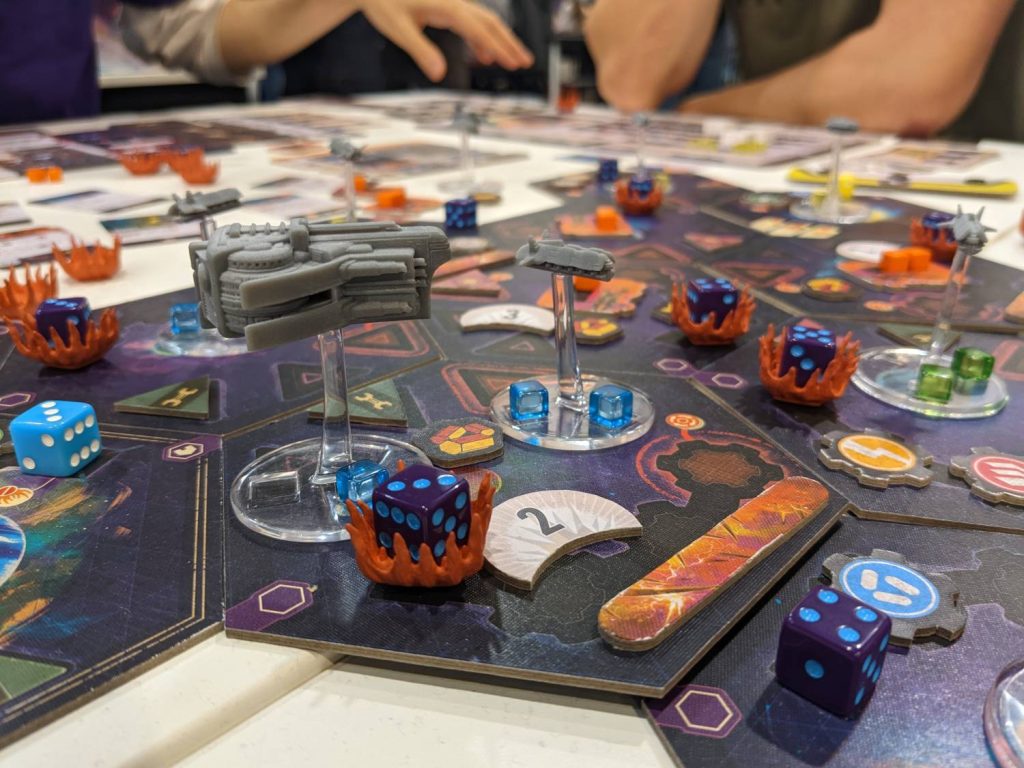
I’ll simply say this: I typically back one, maybe two crowdfunding campaigns a year, but after playing the demo I backed the all-in version of Voidfall just before this article went to publication. I think backers are going to be very happy with this one.
Voidfall is the heaviest game Mindclash has ever released, which I think is saying something. Seriously, this one is a beast, and I believe it will be a four-hour game at four players with big choices and thinky turns.
I only got to play two full rounds (out of three), but I did it with Mihály Vincze, the lead playtester at Mindclash who also had lots of insights about the development of the game. Voidfall aims to fix my biggest issue with Eclipse: Eclipse is a smooth engine-builder for six of its eight rounds before veering into dice-chucker territory when all of the players go to war in the middle of the map to finish the game.
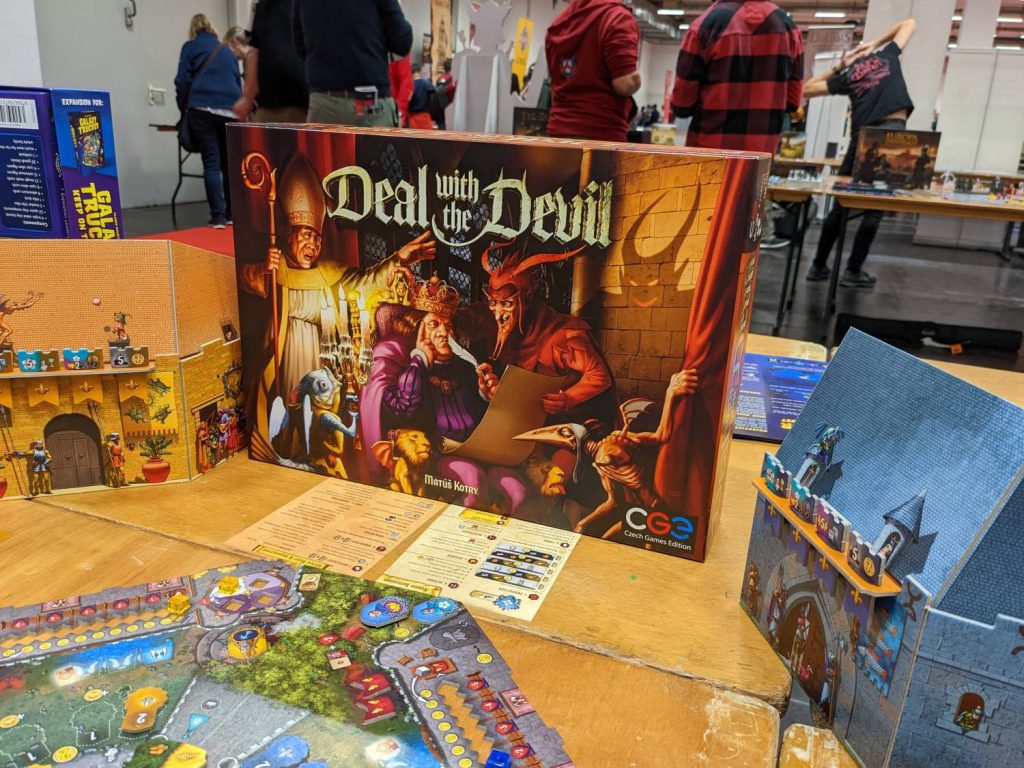
Some players love Eclipse specifically for these reasons, so no quarrel there. I just prefer to play a four- or five-hour space epic which is either a true 4X game, or a dice-chucking beer and pretzels affair. Even during my first play, I can tell that Voidfall is very close to my personal sweet spot: it’s a space epic, with miniatures, ridiculous production elements, just like every other deluxified Mindclash game.
But it’s also a game that features very deterministic space combat, to the point that you may miss being able to get lucky every so often when taking on a foe in PvE or PvP fights. It is also an engine builder with tracks, good asymmetry between factions, and some very juicy technologies that change the game for each player.
With an almost unheard-of 60 scenarios in the base game manual and the possibility that BGG is going to turn into a smorgasbord of player-designed content once the game is in the wild, I think some people are going to play Voidfall 100 times. I review games for a living—assuming that “living” implies that I make zero cash on this endeavor—so I won’t have time to play any single game that often. But rest assured that you will get every dollar’s worth of your investment in Voidfall.
My second night of the main fair ended the way all convention nights should end: drinks with industry types at the Mighty Boards booth, where I had the chance to chat with Mark from Not Bored Gaming about which Lacerda game he thinks solos best (we both agree: Kanban EV), Viktor from Mindclash about triple-layer player boards, and Monique and Naveen from Before You Play about working with various publishers. SPIEL just crushes it on the networking front, and I can’t believe I haven’t seen this at any other conventions.
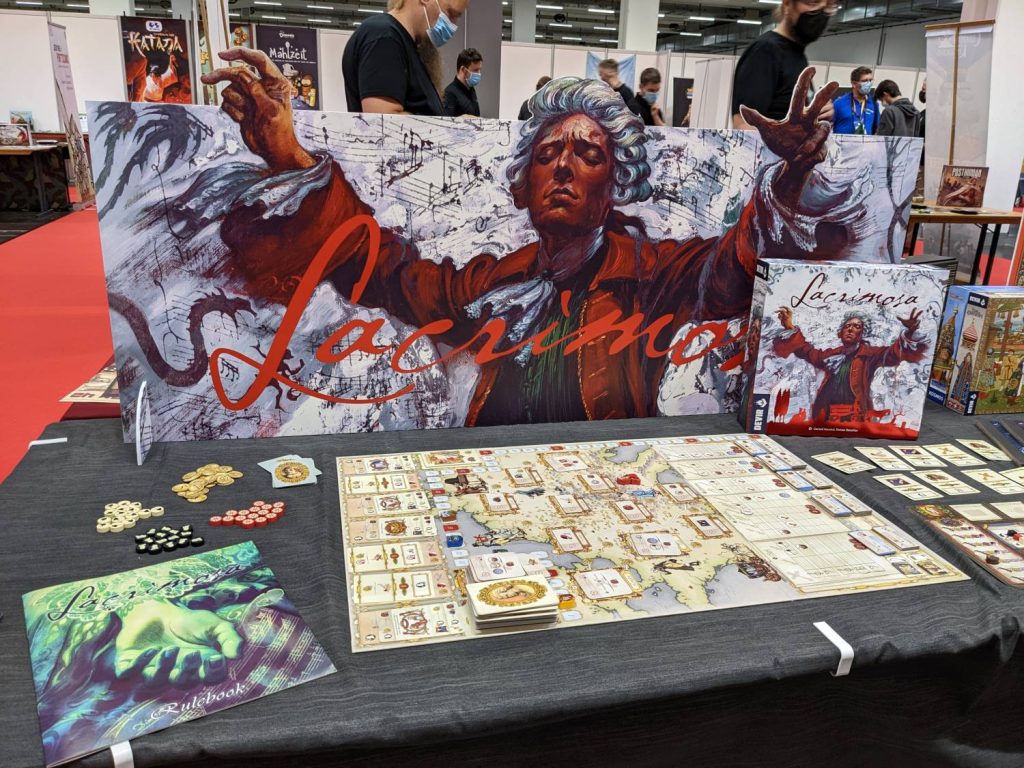
Day Three: Saturdays Means No Thank You
Here’s the best advice I can give you now that I’ve survived a full Saturday on the trade show floor at SPIEL ‘22: absolutely do not go to SPIEL on Saturday.
The place was a zoo. Like all conventions in the tabletop space, Saturdays mean your biggest crowds of the week. But at the biggest show with the biggest crowds, SPIEL is a no-fly zone for the majority of the day when people from all over Europe come to town for one day to buy all of the games they’ll need for a year.
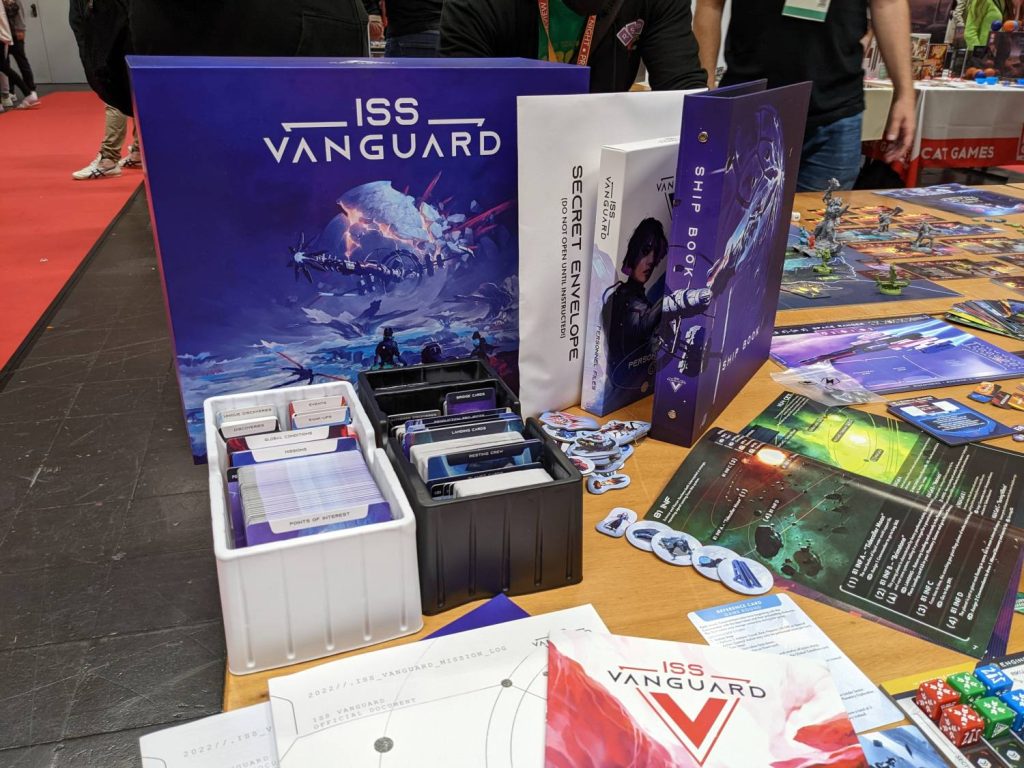
“Stop and stare” seemed to be the mantra of most of the people I ran into on my third day at the fair, and I mean that literally. I physically bumped into a bunch of people because they turned their slow walk into a staring contest with beautiful handmade box inserts for Ark Nova, or cool posters and artwork, or a celebrity designer signing. For someone trying to go from meeting to meeting, these gamers were a nightmare to navigate all day long.
Next year, I’m taking a roadie to Cologne instead. But this year? Fun meetings with contacts at Horrible Guild, Gigamic, and Mighty Boards discussing current and upcoming titles. Horrible Guild’s The Great Split looks like a blast so I’m excited to get that to the table soon. I also had the chance to see luminaries like Vital Lacerda holding court at the Eagle-Gryphon Games booth, and I dropped in on other contacts like Ola from Board&Dice about their upcoming slate, including the announcement of a Teotihuacan “big box” edition that packages the base game and all of the expansions into one production.
I bailed on day three early so that I could begin the process of punching new games and repacking my bags to start prepping for my departure, before hitting a reception for GAMA members at a restaurant near the Messe. That was loud, boozy and fun, but after a long day of navigating crowds, I went home early to get a jump on my bedtime!
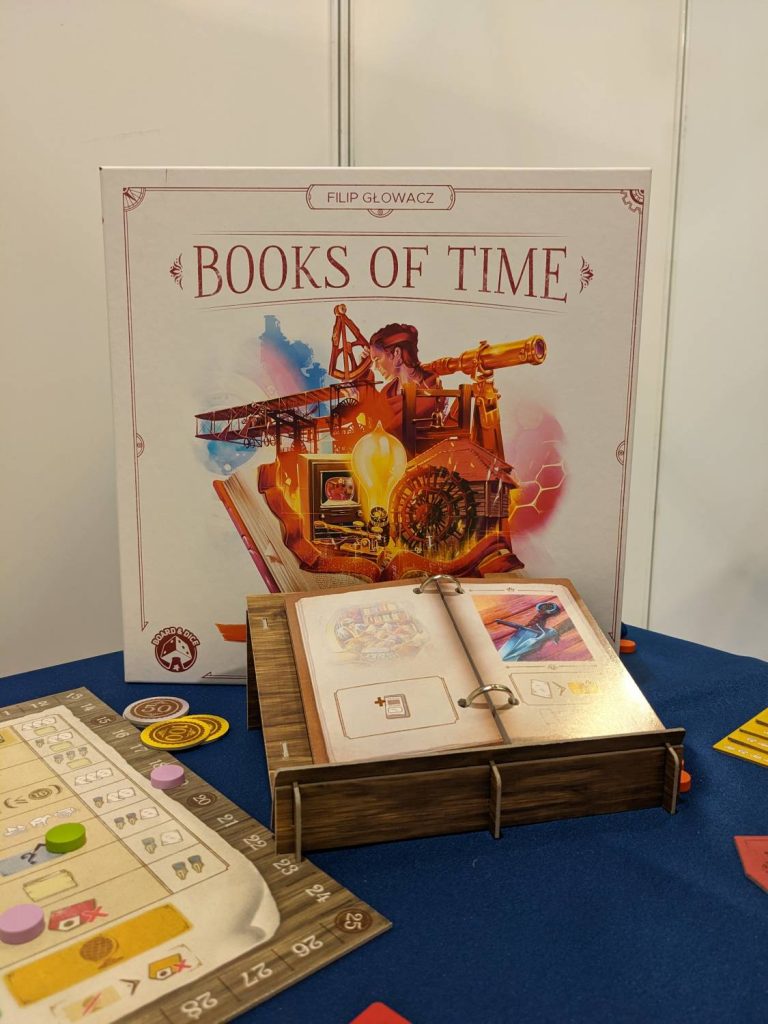
Day Four: Bingo
I got a great night’s sleep going into Sunday’s final open day at SPIEL, and that worked wonders. With only one meeting and a chance to run the floor to grab review copies before the fair wrapped up, I had a great time on a much slower show floor moving around, talking to people, and playing some games for once.
My only play came near the end of the day, when my scheduled demo of Marrakesh from Queen Games kicked off. The newest Stefan Feld game in the City Collection, Marrakesh is a new design and one that feels complicated given the nature of the actions. Like other Feld games, Marrakesh feels like you can score just by drafting your workers in a round, but with only 12 turns and a mechanic that will leave those not going first feeling a little behind, there’s something here, and that was evident after even my first play of a single round.
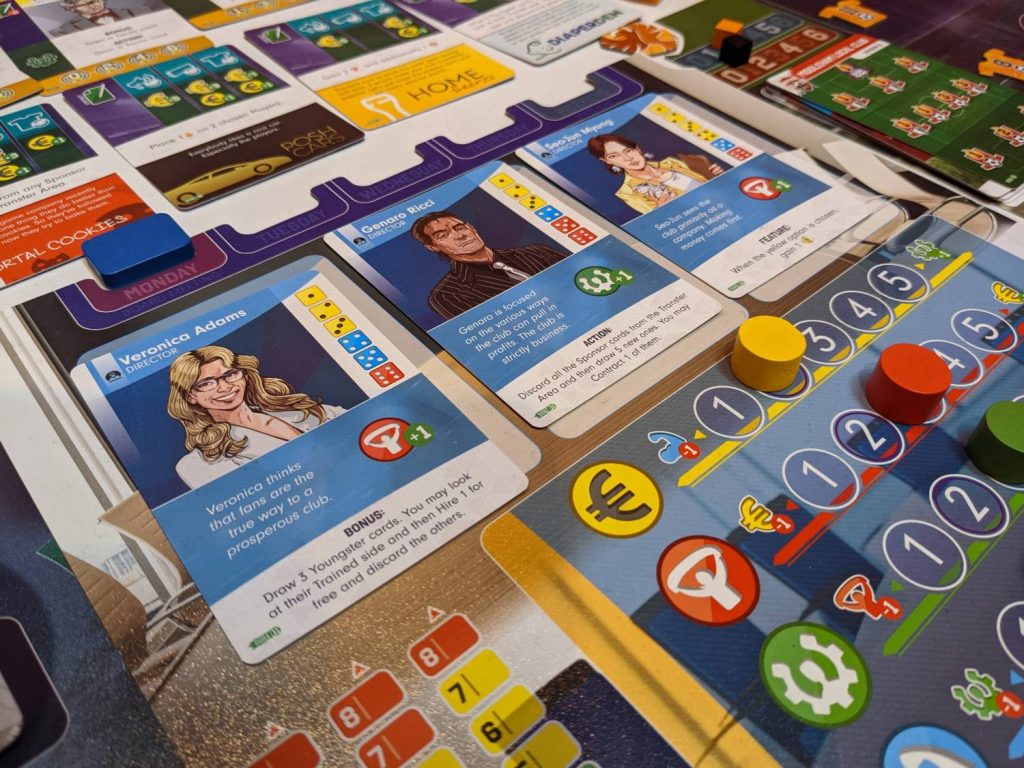
Prior to that I caught up with our international contact at Portal Games, where I received a review copy of the incredibly thematic soccer business management game Eleven. Given the timing—the World Cup kicks off in November—I’m moving Eleven to the front of the line to get a review out in time for the spike in soccer-related web traffic.
In between, I discovered something that I’m still laughing about. There are eight main halls in the Messe Essen, and as I was strolling around looking for publishers I hadn’t spoken to, I realized that Sunday was the first time I had walked into Hall 4.
That’s right—I had been at the fair for 3.5 days, and I hadn’t even been to one of the Halls yet. That’s how massive this fair is, folks! You have to be intentional about where you go each day, and that’s what I will do in the future. Halls 1, 2 and 3 have lots of large publishers who have games we see throughout the year at other conventions, with some bigger anchors to make sure foot traffic is always heavy. In the case of Hall 3 this year, Pegasus Spiele felt like they had half the hall.
Halls 4, 5 and 6 were an interesting mix. These are the halls that feel a bit more like Gen Con, with smaller booths, smaller teams, more independent (read: interesting) games, and small walkways. This meant that even on Sunday, traffic was heavier in those Halls because the halls were smaller, but I liked the disparity between large hall and small hall traffic.
When I come back for future SPIELs, I think I will start my week in those three halls. That way, I can make a hitlist of the games and publishers I want to spend more time with, as well as spend cash at those booths since there were a ton of first-time designers and publishers working the space.
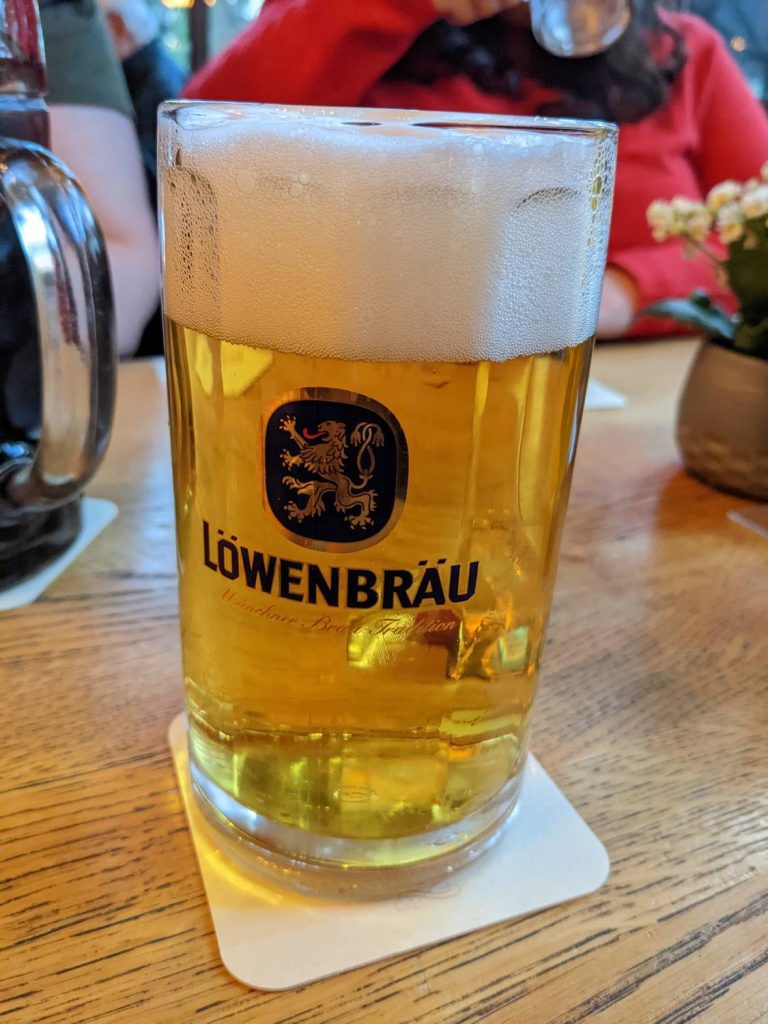
I also got to hang out with my friend Beth from BGG, and we had dinner with Candice Harris and her partner that night. Even though we talked mostly about great food, The Muppets Take Manhattan and molded wine, it’s always a blast to meet more people in this space because of so many common interests. (Well, maybe not the Muppets.) New connections were a running theme throughout the trip so I was thankful to have had the chance to attend.
All of this was something else and I’ve already decided that SPIEL is officially on the list for tabletop trips I need to make each and every year. There are so many new games to explore and so many rich experiences to be made. Yeah baby!!


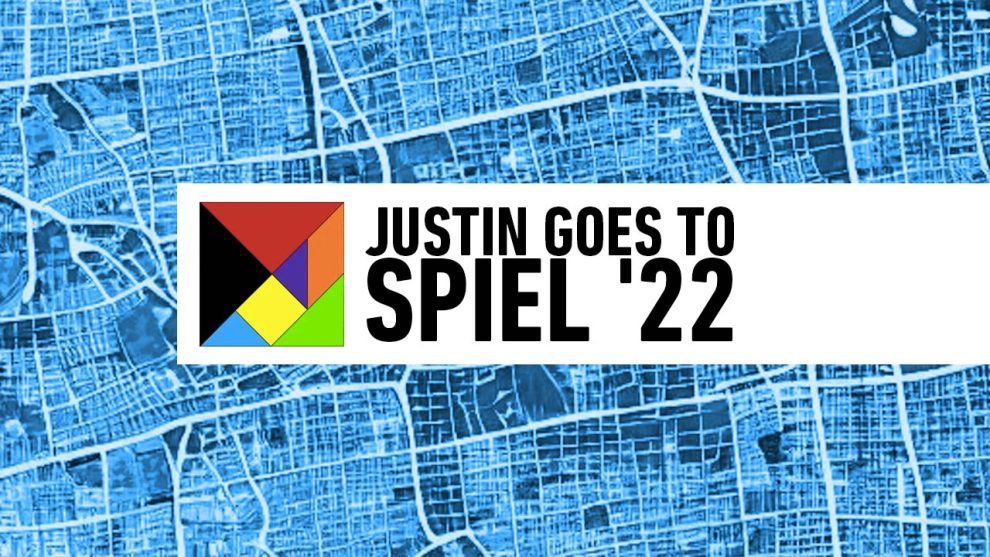
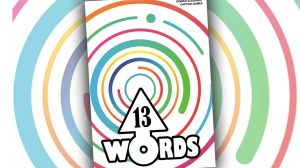


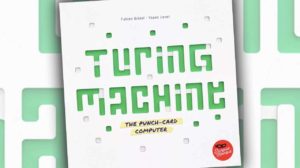




Great overview! As someone who was also running around (as a designer to pitch publishers), it definitely felt like it was back to full attendance… ESPECIALLY on Saturday.
This was my fifth Essen, and there’s definitely a characteristic to each hall. Halls 1, 2, 3 focus on the biggest names in the industry; hall 4 focuses on a broad variety of international small- and medium-sized publishers (this year it felt like the Korean zone!); hall 5 has historically been for indie, small, and some medium-sized publishers; and hall 6 has long been for the RPG and gaming accessories.
That looks like an Oltree expansion I’m one of the pictures….do you know if it was demo or for sale? (studio H)
Good eye. BGG says that’s the Undead & Alive expansion:
https://boardgamegeek.com/boardgameexpansion/352979/oltree-undead-alive
No idea whether it’s FS or not.